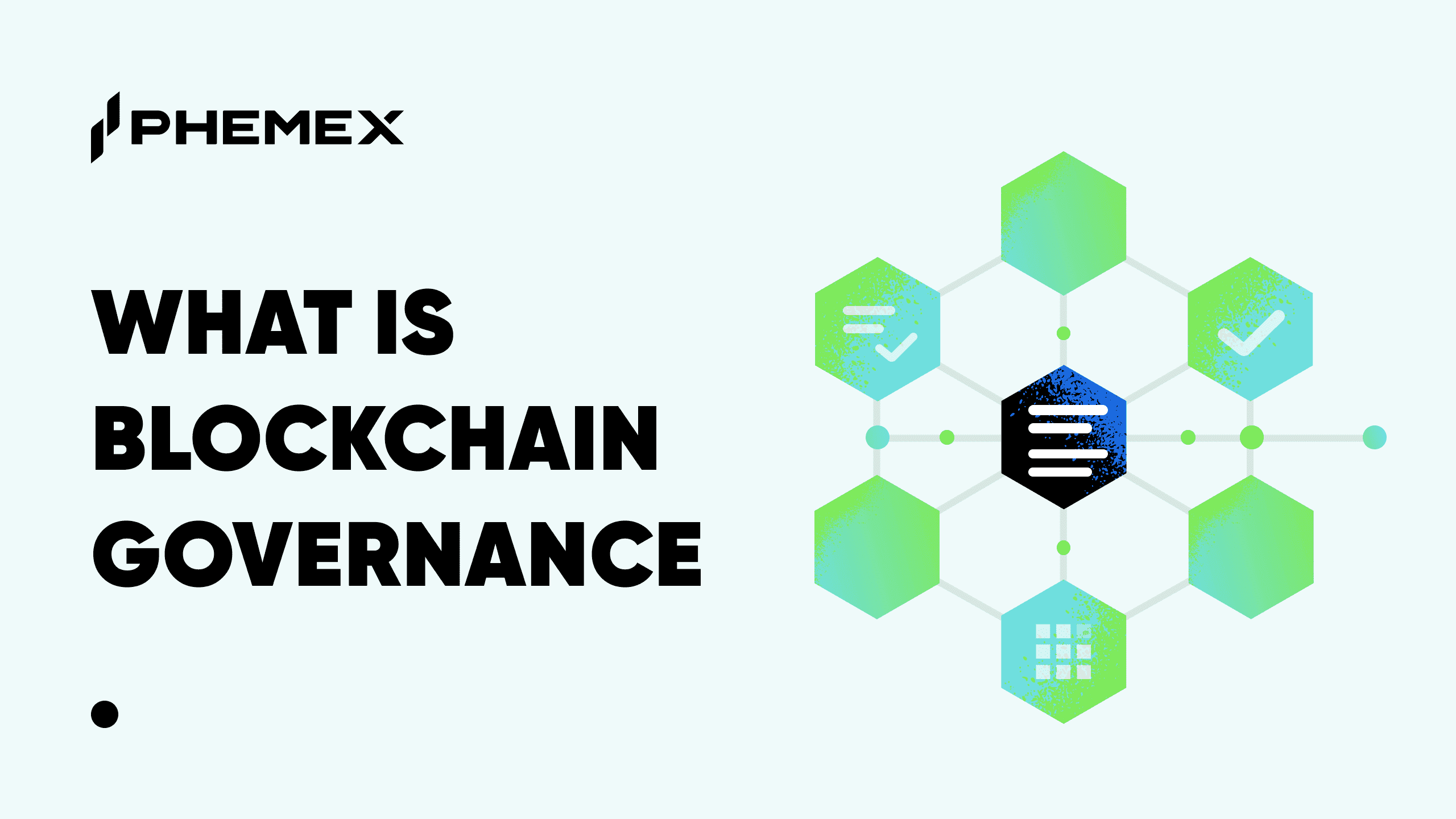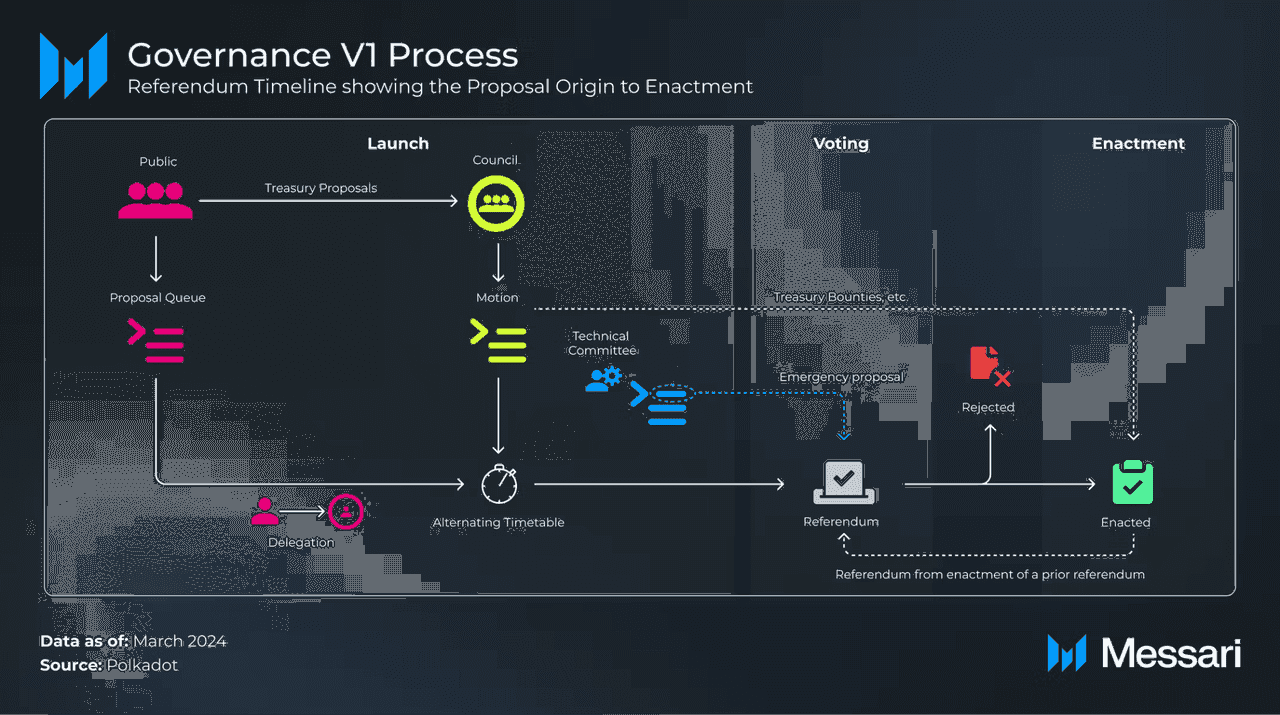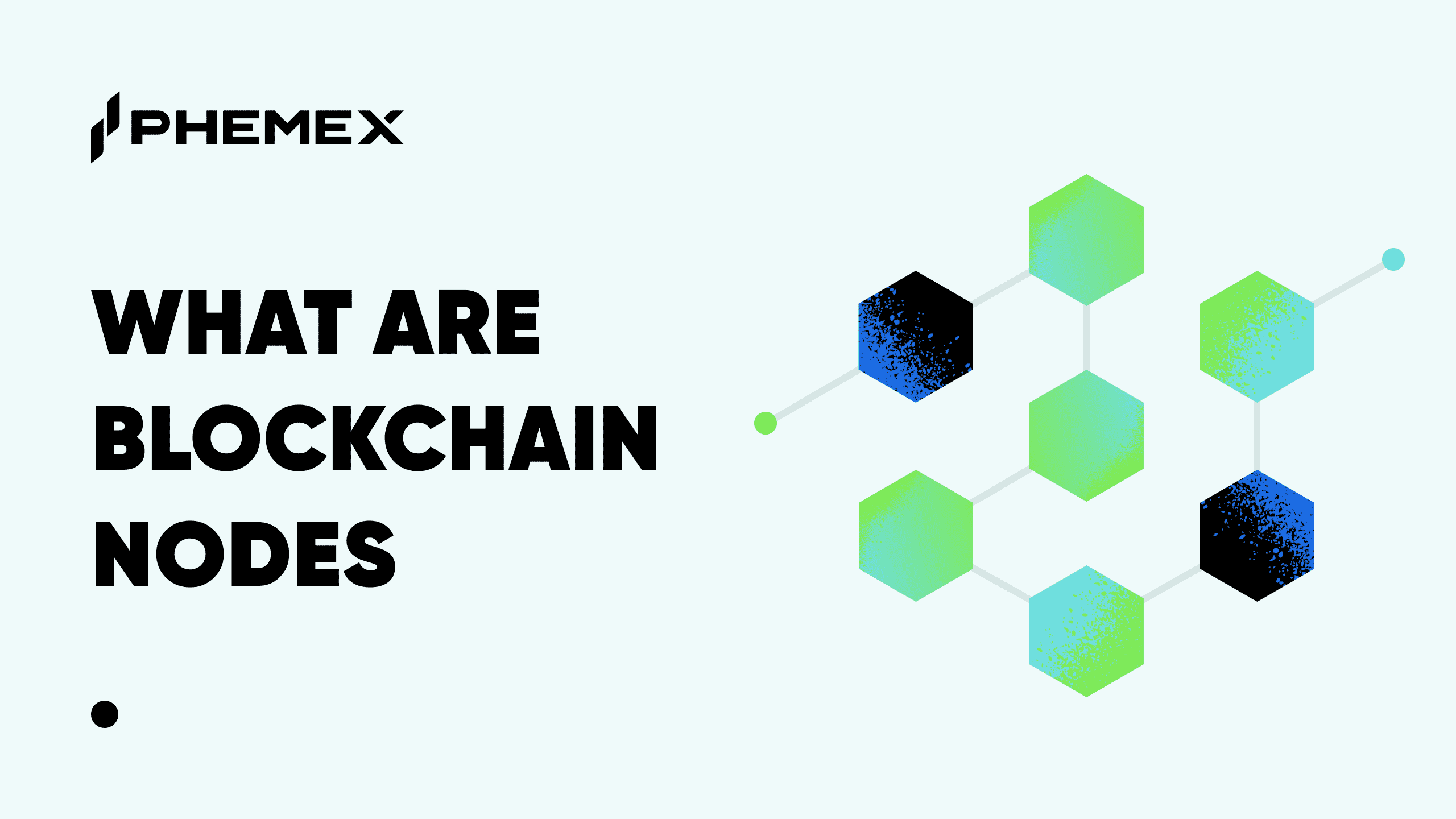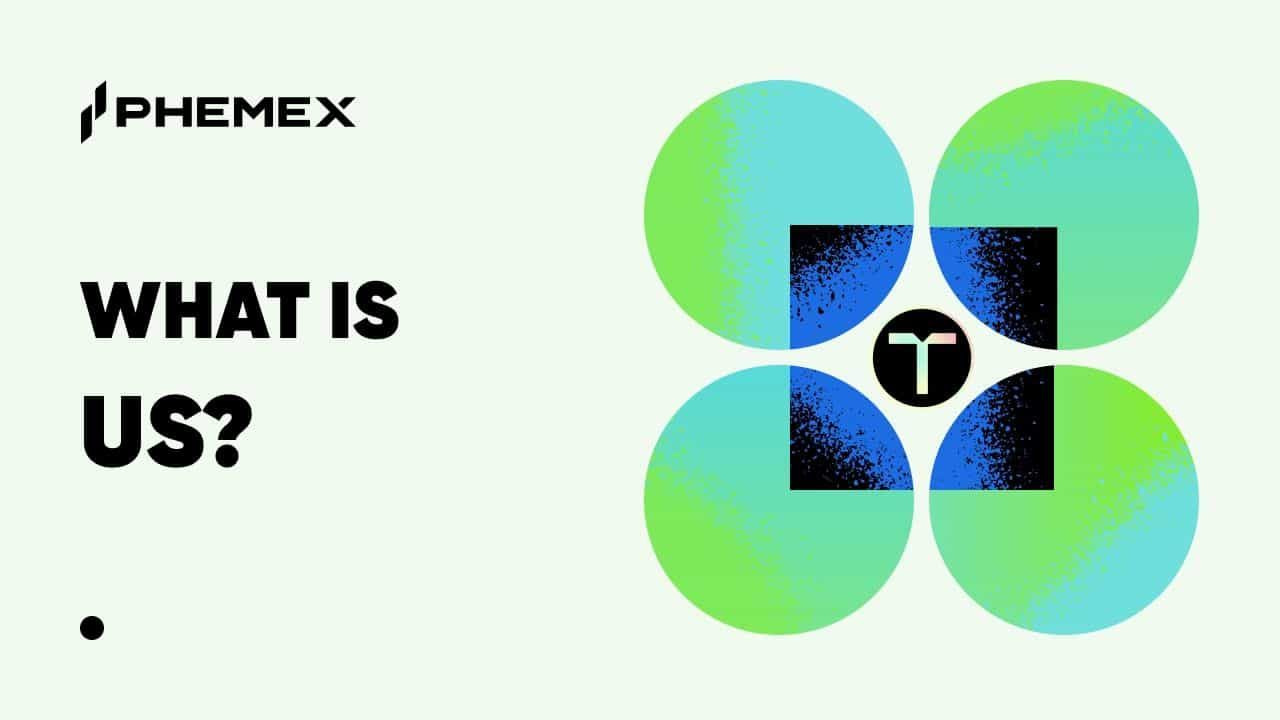Key Takeaways
Blockchain governance refers to the rules, processes, and structures that determine how decisions are made within a blockchain network.
Governance models can be on-chain - meaning automated through code, or off-chain - driven by community discussions and external decisions.
Effective governance ensures network upgrades, dispute resolution, and long-term sustainability without centralized control.
Different blockchains adopt varying governance structures as some are more decentralized, while others rely on foundations or core teams.
Understanding governance is essential for users, developers, and investors participating in decentralized ecosystems.
Blockchain governance refers to the processes and mechanisms through which blockchain networks and crypto communities make decisions about protocol changes, upgrades, and overall direction. In simpler terms, blockchain governance is how the rules of a blockchain get decided, applied, and changed over time. As the crypto ecosystem has grown, governance has become a critical topic – different projects experiment with varying models to balance decentralization, efficiency, and stakeholder interests. This article breaks down the fundamentals of blockchain governance, compares on-chain vs. off-chain models, explores DAO frameworks, highlights notable examples like Ethereum and Polkadot, and examines trends in decentralized governance through 2025.
What is Blockchain Governance?
Blockchain governance encompasses the framework of rules and voting procedures that determine how a blockchain evolves. This includes who can propose changes (like software upgrades or parameter tweaks), how those proposals are approved, and how conflicts or forks are resolved. Good governance ensures a blockchain can adapt and improve over time without a single central authority, maintaining trust among a distributed community of users and developers.
In traditional organizations, decisions are made by executives or boards. By contrast, blockchain networks aim for decentralized governance – meaning decisions are made collectively by stakeholders (such as coin holders, node operators, or delegated representatives) following transparent rules. Effective governance is crucial because it impacts a network’s security, upgrades, and long-term viability. A poorly governed blockchain might stagnate or splinter, while a well-governed one can evolve smoothly even as technology and user needs change.
Key governance elements include:
Decision-Making Process: How proposals (for upgrades, parameter changes, etc.) are introduced and decided (e.g. by token-holder vote, miners, core devs).
Participation: Who gets to vote or influence – for example, token-weighted voting (one coin, one vote) or other mechanisms.
Transparency: Governance rules are usually encoded or clearly documented so all participants know how decisions happen (true to blockchain’s ethos of open source and transparency).
Amendability: The process to change governance itself (meta-governance) if needed, ensuring the system can refine its own rules.
As blockchains matured, two broad governance models emerged: on-chain governance and off-chain governance. Let’s explain each and their differences.
On-Chain vs. Off-Chain Governance in Crypto
On-chain governance embeds decision-making rules directly into blockchain code, allowing voting and outcomes, like protocol upgrades, to occur automatically through smart contracts. Voting typically occurs using governance tokens or the native coin, with holders casting votes proportional to their stake. This approach is formalized and automated.

In contrast, off-chain governance relies on informal processes outside the blockchain. Discussions and votes happen on forums and social media, with decisions implemented through software releases rather than automatically. This method values community consensus but can be slower and more contentious.
Bitcoin and Ethereum exemplify off-chain governance, using Bitcoin Improvement Proposals (BIPs) and Ethereum Improvement Proposals (EIPs) debated off-chain, with changes adopted through broad consensus. Projects like Tezos and Polkadot showcase on-chain governance, where token holders vote on proposals directly. Tezos allows self-executing upgrades, while Polkadot enables a more adaptive governance model with continuous referenda for inclusive decision-making.
Summary of key differences:
On-Chain Governance: Formal voting on the blockchain, rules enforced by code. Pros: transparent, immediate execution of decisions, clear token-weighted power structure. Cons: can favor large token holders (plutocracy risk), code can’t capture every nuance of human judgment, potential for governance attacks if someone obtains a large stake.
Off-Chain Governance: Human and social process off the ledger, then implementation via client updates. Pros: flexibility, room for discussion/iteration, doesn’t require tokens to contribute (meritocratic to an extent). Cons: slower, less transparent (decisions in back-channels or elite circles?), can lead to community splits if consensus fails.
In practice, many blockchains blend both – even with on-chain voting, there’s often off-chain discussion and campaigning before votes. And off-chain systems may eventually ratify decisions through an on-chain action (like a hard fork). Let’s explore some real-world examples of each model to make this concrete.
Examples of On-Chain Governance Models
Tezos: Tezos uses an on-chain voting process for protocol upgrades, allowing stakeholders to propose changes and vote with their XTZ stake. This self-amending design helps avoid hard forks, and Tezos has successfully implemented multiple upgrades seamlessly through this method.
EOS: Launched in 2018, EOS attempted on-chain governance with a constitution and a voting system involving 21 Block Producers. However, it faced criticism for its centralized nature, as powerful stakeholders like exchanges held disproportionate voting power.
Polkadot: Originally featuring a council plus public referenda, Polkadot shifted to Gov2 (OpenGov) by 2022, allowing anyone to start referenda. This model focuses on decentralization, enabling simultaneous proposals with safeguards based on their importance. By 2025, Polkadot's governance model is seen as advanced and community-driven, addressing governance challenges.
DAOs on Ethereum Layer 1: Many Ethereum-based protocols, like MakerDAO and Uniswap, utilize on-chain governance through their DAO structures, allowing token holders to vote on changes. This represents application-level on-chain governance despite Ethereum’s base layer being governed off-chain.
Examples of Off-Chain Governance Models
Bitcoin: Bitcoin governance is informal, relying on peer review and community consensus without a formal on-chain voting mechanism. Changes take time to achieve agreement, ensuring stability but slowing upgrades.
Ethereum: Ethereum’s governance also operates off-chain, utilizing the Ethereum Improvement Proposal (EIP) process. Changes are discussed among developers, and implementation occurs through consensus rather than formal voting, maintaining community-driven upgrades.
Others: Many public chains have historically relied on off-chain governance, like Litecoin and Solana, often directed by teams and foundations. This model can work well in early stages but may face challenges during disputes.
Governance Tokens and DAOs
A significant development in blockchain governance is the rise of governance tokens and DAOs (Decentralized Autonomous Organizations). Governance tokens, which gained popularity starting around 2017 and peaked during DeFi summer 2020, grant holders voting rights in a protocol, allowing them to influence decisions such as fee changes, feature additions, and treasury allocations. For instance, Uniswap’s UNI token enables voting on proposals like fee structure adjustments.
Voting typically occurs on-chain, where proposals are discussed before token holders cast votes. If a proposal meets quorum and passes, changes are executed by the governance smart contract or implemented by core teams.
DAOs are blockchain-based organizations governed via smart contracts. They can manage anything from protocols to investments and social groups, allowing decentralized decision-making. Various frameworks like Aragon, DAOstack, Snapshot, and Moloch enable the creation of DAOs with tailored governance rules. By 2025, DAO tooling has advanced, allowing for features such as quadratic voting and vote delegation, while notable practices include delegating votes to active representatives and multi-signature councils for operational decisions.
Ethereum vs. Polkadot Governance – A Case Comparison
To illustrate the contrast between off-chain and on-chain governance, let’s compare Ethereum and Polkadot as of 2025:
Ethereum Governance: Primarily off-chain, driven by the Ethereum Core Devs and the Ethereum Improvement Proposal process. Protocol changes rely on social consensus among developers and stakeholders rather than direct voting by ETH holders. Major upgrades, like the 2022 Merge and the 2024-2025 danksharding, were determined through extensive discussions, with users opting in by upgrading their software. While this approach helps avoid chain splits, it can lead to slow consensus on complex issues.
Polkadot Governance: Fully on-chain and agile, allowing any DOT holder to propose referenda and vote with their tokens at any time. This flexibility enables quicker decision-making, and by late 2025, many proposals had been passed, from runtime upgrades to funding projects. Polkadot encourages participation through conviction voting and delegation, ensuring broader involvement. However, ensuring sufficient voter turnout remains a challenge.
In summary, Ethereum emphasizes a cautious, socially-driven model, while Polkadot exemplifies on-chain democracy, reflecting their respective philosophies of security and decentralization.
Polkadot Governance (source)
Pros and Cons of On-Chain Governance
Both governance models have their vocal proponents in the crypto space. Let’s summarize the main arguments on each side:
On-Chain Governance – Pros:
Transparency and Immutability: All votes and proposals are public on the ledger. It’s clear what decision was made, when, and by whom (which addresses). This open record can increase trust in outcomes.
Efficiency and Speed: Decisions can be executed automatically once voting concludes – no need for coordinating manual upgrades if the code change is part of the proposal. This can enable faster iteration (no waiting on miners or validators to adopt changes).
Direct Stakeholder Voice: Coin holders directly influence the network proportional to their stake. There’s a feeling of empowerment for investors/users to shape the project’s future. It’s a mechanistic democracy: if you invested in the network (hold tokens), you have a say.
Prevents Stalemates: If structured well, on-chain votes avoid deadlock – e.g., a simple majority or supermajority decides, rather than endless debate. It forces decisions to a binary outcome by a deadline.
Innovation in Governance Experiments: On-chain systems allow trying novel governance ideas (quadratic voting, conviction voting, vote markets, etc.) since it’s all code. It’s easier to program new governance features than to coordinate new off-chain processes.
On-Chain Governance – Cons:
Plutocracy Risk: Voting power tied to token ownership means the wealthy or early whales can disproportionately influence decisions. This can undermine decentralization if a few entities accumulate large stakes. For example, if an exchange or venture fund holds a big chunk of tokens, they could sway votes in their favor.
Voter Apathy and Low Participation: Many token holders don’t participate in governance, leading to low turnout. If only a small active minority votes, they effectively control the outcome. Projects combat this with incentives and delegation, but it remains a challenge.
Smart Contract Bugs or Exploits: If governance processes are coded, any flaw can be catastrophic. There have been instances where attackers accumulated tokens (or borrowed via flash loans) to pass malicious proposals – e.g., in 2022, an attacker got a majority in a DeFi project’s governance and drained funds. Robust design (time locks, security audits, token-based quorums) is needed to mitigate this.
Infighting on-chain: Constant voting can also lead to governance fatigue or factionalism, where communities split into voting blocs. It could even result in on-chain governance wars – though rare, the mere possibility requires vigilance.
No Guarantee of Quality Decisions: Just because it’s on-chain doesn’t mean decisions are good. Token voters might not be experts; they might pass shortsighted changes if misinformed or if there’s voter manipulation. In off-chain governance, by contrast, expert developers have more sway which can be beneficial for complex technical matters.
Off-Chain Governance – Pros:
Flexibility and Context: Humans can discuss nuances, negotiate compromises, and consider off-chain factors. It’s not bound by rigid code rules, so extraordinary situations can be handled with judgment. (For example, responding to an unforeseen crisis or bug by quickly coordinating a fix, as was done in Ethereum’s early days with the DAO hack rollback – a controversial but context-driven decision).
Inclusive beyond Token Holders: Off-chain processes can incorporate voices of developers, users who may not hold many tokens, researchers, etc. Influence comes from reputation and contributions, not just stake. This can lead to more meritocratic inputs (though final say often still lies with those running nodes).
Prevents Hasty Changes: The slower, deliberative nature can act as a buffer against rash decisions. It’s harder for a single party to push through a change quickly; thus core principles (like Bitcoin’s 21M cap) are extremely unlikely to change without overwhelming community agreement.
Social Legitimacy: If done well, off-chain consensus building yields broad buy-in, so when a change happens, the community is largely united behind it. There’s less “I didn’t know this vote was happening” feeling.
Resilience to Token Takeover: Since decisions are ultimately implemented by users choosing software, an attacker can’t just buy tokens and enforce a change unless the community willingly runs that code. This social check can neutralize a potential governance exploit where a hostile entity buys a majority of tokens.
Off-Chain Governance – Cons:
Slower and Can Stall: Achieving social consensus is often slow. Important upgrades might take years or get stuck if there’s persistent disagreement (one example: debates over increasing Bitcoin’s block size in 2015-2017 led to a staleMate and eventually a split forming Bitcoin Cash). Without a formal vote, it can be unclear when consensus is reached.
Opaque or Less Accessible: If you’re an average user, it’s not always clear how to get involved or who to talk to. Much happens on GitHub or developer calls – environments not everyone is comfortable in. There’s a risk of a small group of insiders (core developers, foundation members) having outsized influence behind closed doors, effectively a technocracy. Though discussions are often public, understanding them requires expertise.
No Immediate Enforcement: Even after off-chain agreement, you rely on miners/validators and exchanges to adopt updates. Some might resist or delay (for example, miners resisted Ethereum’s EIP-1559 fee burn at first due to reduced fees for them, though it eventually passed). If a significant minority doesn’t update, you risk chain splits.
Difficult to Measure Sentiment: Without on-chain votes, gauging overall community sentiment is tricky. One uses proxies (forum polls, social media, hash power signaling), but these can be imprecise or manipulable (Sybil attacks on polls, etc.). This sometimes makes decisions feel fuzzy or contested even after implementation.
Less Innovation in Governance Tools: Off-chain governance can’t easily implement new voting schemes or automated processes. It’s mostly social coordination. As a result, improvements in governance might lag or rely on developing off-chain tools (like Snapshot for sentiment polling) rather than leveraging the blockchain’s strengths.
Both models continue to evolve. Many projects aim for a hybrid approach: using off-chain deliberation to vet ideas, then on-chain mechanisms to formalize the decision. Decentralized Autonomous Organizations (DAOs) are a prime example where community discussion (off-chain or on forums) precedes an on-chain vote for final decision. Even Bitcoin’s off-chain model has been augmented with mechanisms like miner signaling, user-activated soft forks (UASF), etc., to inject some structure into the process.
On-chain vs. Off-chain Governance (source)
Trends in Decentralized Governance (2023–2025)
As of December 2025, blockchain governance is a vibrant area of experimentation. Here are some notable trends and developments in the last few years:
Rise of DAO Treasuries and Treasury Governance: Many projects have built large treasuries for community-run grants, facing governance challenges like preventing nepotism. By 2024–2025, treasury allocation discussions have become common, with some DAOs like Uniswap and Compound forming committees to enhance governance, blending aspects of corporate practices while retaining token holder oversight.
Delegation and Voter Participation Improvements: To address low voter turnout, projects like Optimism’s Token House encouraged vote delegation, leading to a rise in participation. Tools such as Tally and Boardroom facilitate this, increasing engagement by over 20%. By 2025, better delegate discovery tools emerged, allowing for informed delegation based on profiles and track records.
Governance Incentives (and Voter Apathy Solutions): To combat voter apathy, DAOs experimented with incentives, like rewarding tokens for participation. However, one-off rewards were ineffective, prompting exploration of longer-term structures, such as staking governance tokens to earn rewards. The goal is more inclusive participation rather than allowing a few voices to dominate.
Security Measures – Guarding Governance: To counter governance attacks, many protocols implemented circuit-breakers and time-locks on votes (2–7 days) for community reflection on passed proposals. Quorum rules and dual voting thresholds were introduced to prevent large holders from having disproportionate influence, alongside trials of whale caps and quadratic voting.
Regulatory Recognition of DAOs: By 2025, more jurisdictions recognized DAOs as legal entities, enhancing accountability. This raised questions about the liability of governance participants, particularly regarding the legality of voted proposals, with some DAOs establishing legal review teams for proposals.
Innovations in Governance: In 2025, AI tools began assisting in analyzing proposals, and the concept of Sortition, or randomly selected governance councils, was introduced to streamline decision-making. These innovations aim to enhance governance scalability as communities grow.
Inter-Protocol Governance: As DeFi protocols often hold one another's tokens, the concept of meta-governance emerged. This involves one DAO voting on another’s proposals using their tokens, fostering cross-project governance and collaboration.
Conclusion
Blockchain governance has evolved significantly from its origins in "rough consensus and running code." Today, it ranges from informal off-chain governance (like Bitcoin and Ethereum) to formal on-chain governance (as seen in Tezos and Polkadot). Each model reflects different philosophies of stability versus decentralization, with no one-size-fits-all solution.
By 2025, the trend is moving toward more decentralized and direct participation through on-chain voting and community DAOs. Many projects that start centralized aim to progressively decentralize governance. We also see a blend of models, combining off-chain discussions with on-chain voting and platforms like Snapshot to engage a broader audience.
In essence, blockchain governance is about managing decentralized communities without central authority. On-chain governance offers transparency and automation, while off-chain governance allows for flexibility and human insight. Finding effective hybrids, like Polkadot’s OpenGov and DAO experiments, is crucial.
As users or investors, it's important to understand governance in your chosen blockchain or DeFi protocol and engage actively to shape the decentralized future. Blockchain governance remains an ongoing experiment in collective coordination, continuously evolving as we learn from various experiences in the crypto space.
Beyond governance, a core aspect of the crypto world is trading functionality, which is where the Phemex exchange shines. Looking to put your crypto knowledge into action? Phemex is a secure and user-friendly exchange where you can buy, sell, and trade a wide range of digital assets. With advanced trading tools, low fees, and robust security, Phemex empowers both beginners and experienced traders to navigate the crypto markets with confidence.










